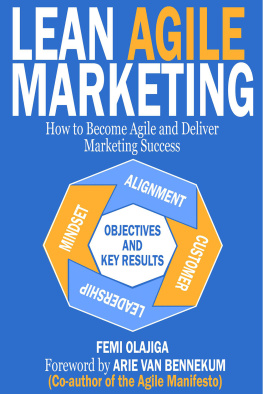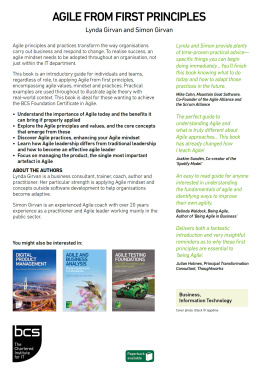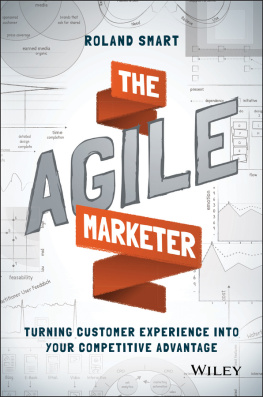
FEMI OLAJIGA
Foreword by ARIE VAN BENNEKUM
(Co-author of the Agile Manifesto)
LEAN AGILE
MARKETING
How to Become Agile and
Deliver Marketing Success

Published in the United Kingdom in 2017 by CX Conversion Ltd.
11 The Approach, Northampton, Northamptonshire, NN5 5FF
Content Femi Olajiga, 2017
Foreword Arie van Bennekum, 2017
Case Study One Peter Eggleston, 2017
Case Study Two Julee Bellomo, 2017
Case Study Three Emma Sharrock, 2017
Case Study Four Michael McKinnon, 2017
Case Study Five Mia Kolmodin, 2017
Case Study Six Sam Zawadi, 2017
Case Study Seven Monica Georgieff, 2017
Case Study Eight Peter Billante, 2017
Case Study Nine Marina Simonova, 2017
Illustrations and Graphic Design Antonija Saric, 2017
The authors have asserted their right under the Copyright, Designs and Patents Act, 1988, to be identified as the authors of this work.
All rights reserved. No part of this publication may be reproduced or transmitted in any form or by any means without written permission from the publisher.
British Library Cataloguing-in-Publication Data
A CIP record for this book is available from the British Library
ISBN Print: 978-0-9957465-0-3
ISBN eBook: 978-0-9957465-1-0
Printed and bound by Amazon.com, Inc.
Typeset by Antonija Saric
Thank you to the thousands of agile leaders around the world for creating the agile values and principles that marketing teams can learn from to sharpen their thinking and shift their mindset.
Thank you to my family: Olori, Bubu, my parents, siblings, Nonne, my relatives and Bestie & Co. And in remembrance of the special people we lost too soon, I will never forget you: Yeye Akogun and Nonno.
Contents
About the Author
Femi Olajiga is an agile marketing consultant, trainer and coach. He enables companies to become agile across marketing to drive business growth. He is also a T-shaped marketing professional with over 10 years of experience in digital strategy development, search marketing, web analytics, customer experience, content marketing and was part of agile marketing teams in both B2B and B2C companies operating in a wide range of industries, including: IT, software development, pharmaceuticals, telecommunications, retail, marketing, media and non-profits. He has extensive experience of training and mentoring marketing teams towards developing and executing successful integrated Agile marketing strategies. Femi holds an MSc in Marketing from Heriot-Watt University and is currently working on completing his ICF executive coaching certifications.
Femi is certified in Google analytics and customer experience, as well as value proposition development, with extensive hands-on experience of agile marketing implementation (Certified Scrum Master), with an emphasis on Lean principles. Using the Agile Marketing framework, he helps companies evaluate and optimise their customer experience touch points to increase customer acquisition, customer retention and customer lifetime value so they can grow their bottom line.
Foreword
by Arie van Bennekum
Back in 1994 it was for me a very conscious choice: this is how I dont want to work anymore. Yes, of course, my background is in IT and at that time I was working as a technical designer, but that does not mean that my focus was limited to the professional domain of IT. When I took my first steps in 1994 in what we call Agile today, it was always as a project manager responsible for a full delivery solution to development projects. Everything was in there: legal, ops, dev, marketing, communication there were no exceptions. It was the whole package, from start to finish, from scratch to operational use, including adapting business processes, training people, connecting marketing campaigns, and implementing operational teams.
The question always was and still remains how can we best employ this efficient and effective way of working as one team, sometimes containing as many as 40 people? I remember many evenings trying to figure out how to do it and then the next day putting it into practice. This is for me what real Agile has always been and always will be: experimenting, reusing best practice, and therefore as an individual, being open to learn from others best practice, and learning (sometimes hard) lessons. And a lesson learned means not stepping back into old routines when things go wrong. It means looking at how we can make it work within this efficient and effective way of working.The professional domain of marketing is already familiar with the Agile concept, at least in the region of the world where I spend most of my time. We have early adopters and innovators across the world and in every profession. In the marketing world there have been some very interesting publications already. Here is another one. With Femi Olajiga taking the lead, he has brought together his own practice, ideas and relevant case studies from Agile marketing leaders around the world. Read the book and try out what works well for you. Adopt the proper attitude towards this hard labour of achieving your goal. Be guided by the Agile Manifesto, experiment with Femis suggestions, and reap your benefits. Enjoy!
Introduction
In order to market effectively, it is vital to consider an iterative approach to planning which is regularly informed by customer experience insights. As such, this is the first book on agile marketing that has been based on the collective experience of agile marketing professionals, reflecting their varied approaches to adopting agile within marketing and sales teams. It provides an in-depth insight into how agile marketing professionals are implementing agile methodologies within their campaign planning and execution.
Chapter one introduces the core concepts of agile and discusses agile values and principles in the context of marketing teams - without recourse to any IT jargon. The chapter also outlines the thoughts of agile marketing thought leaders from around the world on the essential elements of agile marketing. Chapter two explores the role of mindset in the adoption and successful adaptation of agile for marketing purposes, with an emphasis on emotional intelligence, personality types and the role of personal development in the successful implementation of agile within teams. Chapter three emphasises the role of customer insights in shaping an organizations marketing strategy. Particular attention is paid to how marketing teams can improve customer experience through detailed customer research, customer profiles, customer segments and customer journey maps. This chapter also highlights the role of customer journey mapping in aligning the various silos within the organization in order to create a seamless customer experience. Chapter four then delves into the practicalities of implementing agile within a marketing context, highlighting the role of a detailed situation analysis and identifying challenges that teams are likely to face in this process, as well as benefits they are likely to experience. Chapter five is the concluding chapter which comprises a series of practical case studies contributed by practitioners within the industry. These agile marketing thought leaders share their individual stories about how they implemented agile marketing within their teams. Each case study provides a different angle on agile implementation within different organizational contexts, from IT (software development) to marketing, sales, human resources and project management functions.
Next page








